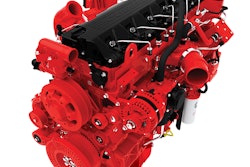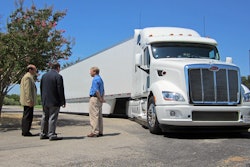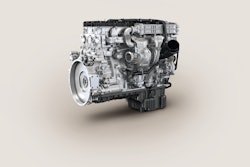
After more than 10 years in the making, hundreds of patents and billions of dollars invested, a new generation of clean diesel engines is here, well beyond the test labs and increasingly found under the hood, on the jobsite and moving into the mainstream in all its glory, but with virtually no emissions.
It’s been a long and defining journey. Not every engine, emissions control device or strategy was a home run. Valuable lessons have been learned along with a whole new lexicon: EGR, CRT, VGT, LNT, DEF and SCR. Hard to imagine that just a decade ago, diesel engines had few or none of these technologies.
The transformational changes that define new clean diesel technology have truly changed the world view on diesel—still the icon of work and efficiency but no longer the icon for air pollution.
This change in diesel is manifesting itself in many places. Ten years ago, skeptics frequently opined doubt that Americans would or could ever embrace diesel cars after the failed 1980’s legacy experience and the negative views on heavy-duty trucks and some off-road equipment. At the end of 2012, diesel car and pick-up sales were up 24% compared to previous years, still representing only about 3% of all new vehicle sales. Recent announcements of a new Cummins 5.0L V8 diesel option for the Nissan Titan pick-up and a diesel engine option in the Ram 1500 pick-up are clear indicators about the growing acceptance of clean diesel power.
At the larger end of the spectrum, new generation heavy-duty trucks are also on the road. Of the Class 4 to 8 trucks on the road today, 29% are from 2007 or newer; 11% are 2010 and newer models. These trucks are indisputably clean, with the newest ones returning a 3 to 5% gain in fuel economy compared to previous years.
The off-road sector has been on the same clean diesel journey—trailing highway vehicles by about five years and with less time to accomplish the same clean air goals—and has arrived with Tier 4 Final technology, set to roll out in January 1, 2014 for the higher horsepower ranges.
The new generation of diesel power now is a participant in a future focused on greenhouse gases (GHG), sustainability and energy efficiency.
CO2 is the new NOx and PM
Having met the challenge of reducing oxides of nitrogen (NOx) and particulate matter (PM) while balancing customer needs, the industry is well equipped to reduce the more complicated CO2 (carbon dioxide – the primary greenhouse gas emitted through human activity1) emissions and increase fuel efficiency.
There are more climate change regulations in place and being implemented on diesel car and truck engines than even the power-plant sector. For heavy-duty commercial trucks, Phase 1 of efficiency regulations that focus mostly on the engine and expand deployment of on-the-shelf technologies is segmented for implementation starting January 1, 2014. Discussions are well underway for Phase 2 reductions in the 2017-and-beyond timeframe. This is where everything gets more complicated, harder to measure or model, and with significant customer concerns entering the picture.
At this point, there is no discussion from the U.S. Environmental Protection Agency (EPA) about regulating CO2 reductions and efficiency standards for off-road machines and equipment. A lack of regulatory requirement has not deterred manufacturers from innovating advanced systems to lower fuel consumption and improve efficiency, and they’re doing it by leveraging the equipment’s duty cycles, cutting idle time and parasitic loads, and increasing machine productivity with GPS -based communications and task control.
We haven’t heard the last of the emissions story
While reaching these near-zero emissions milestones has been cause for celebration, by no means have we heard the last of regulations on criteria pollutants like NOx and PM. The California Air Resources Board (CARB) has, for the last year, been discussing “future voluntary NOx reductions” for heavy-duty trucks. It’s hard to imagine getting nearer to zero emissions than today, but the chatter is along the lines of reducing the emissions by half of current levels to meet the 2025 ozone clean air standard. What exactly would it take for a further 50% reduction of NOx? More importantly, what would it cost? Is it a tweaking of current SCR technology or the use of different fuels? Half of near zero will be harder than half from Tier 0.
The Europeans in 2011 began implementing new requirements for PM that also regulates the number of particles emitted rather than just the total mass of the particles, as is today’s practice. California air regulators have also been looking at the ultra-fine particle science. This becomes an issue not just for diesel engines but also some advanced gasoline engines that are using diesel-like direct injection, which in turn produce more particles.
Aftertreatment necessities?
Meeting the Tier 4 off-road standards has been a monumental task thanks to the sheer combinations of machines, engine sizes and horsepower ratings; and consequently, engineering emissions-reducing solutions has not taken a one-size-fits-all approach. In some cases, the lack of emissions technology used is making a bigger statement than the technology that is used. The fact that many engines may not need particulate filters to meet the low PM standards is disconcerting to some stakeholders, who have identified a particulate filter as a tangible component of clean diesel. Without it they say near-zero emissions can’t be assured over the life of the engine or machine and that the filter is “an insurance policy.” Stand by for much more discussion on that one.
Clean Diesel 2.0
The diesel engine of the future will likely be smaller in displacement, use fuels other than just #2 diesel, be more integrated with hybrid powertrains, have simpler emissions control systems, and be cleaner and more efficient. These aren’t really predictions so much as present-day realties.
The downsizing trend exists in passenger car diesels where engineers are on their second or third generation technology. Engines are shrinking not by cc’s but by cylinders; from six cylinders down to four (e.g. Mercedes, BMW) to achieve higher fuel economy targets and cut the cost of emissions control systems. More sophisticated combustion control and multiple turbochargers are picking up the slack, with SCR technology to be an increasingly standard player in most light-duty cars and pick-up trucks.
Electric motors and hybrid powertrains
Diesel electric hybrid transit buses that use a downsized diesel engine and hybrid powertrain are now the most popular advanced technology for leading transit agencies. But, in applications where one would think hybrid technologies to be most likely—i.e. passenger cars and light trucks—there are none to be found. Dive into the sectors like construction equipment and marine engines where it is least expected, and they’re everywhere from hybrid wheel loaders, excavators and dozers from Caterpillar, John Deere, MTU, AGCO, Yanmar and Volvo.
Finding ways to allow diesel engines to operate within the “sweet spot” of lower emissions formation and highest fuel efficiency has been a hallmark of construction equipment engineers. Disconnecting mechanical and hydraulic linkages and replacing them with electrical ones is creating new opportunities for efficiency. The power demands for off-road engines are cyclical and can come on big and fast, so ways to smooth out that transient curve return significant savings in fuel efficiency and lower maintenance and operating costs. More electric motors doing the work of belt-driven wheels and pulleys can only continue in the future.
Don’t assume a diesel engine is burning diesel fuel
Discussions or reference to the diesel engine have always been taken with the inference that the engine was running on diesel fuel. Today, just about all diesel engines—with the exception of some very large marine engines—are running on ultra-low sulfur diesel fuel (ULSD). That’s probably going to change in the near future because of the use of more biofuels in the mainstream fuel supply and the diversification of fuels, driven both by the nation’s focus on climate change and its desire to reduce reliance on imported oil, but also to seek out lower cost alternatives to the diesel engine. Expect more diversification of fuels in niche applications where fuel type and composition might be custom-tailored to local or regional air quality demands. A classic example of this is the move to using not only ULSD but also more biodiesel blended into home-heating oil in the Northeast.
Last year, just over 1.2 billion gallons of biodiesel fuel were produced in the U.S. while the overall on-road fuel use is anywhere from 35 to 40 billion gallons annually. Getting to bigger volumes and higher blend ratios of renewable biofuels requires more confidence in quality and consistency of the fuel by both users and manufacturers.
The policy push is unquestionably to lower-carbon fuels. From the federal side, the Renewable Fuel Standard (RFS) is driving larger quantities of biodiesel and ethanol into the mainstream fuel supplies. In California, it’s a low carbon fuel standard slated for final adoption by the end of the year. In some cases future engines won’t even be running on diesel or biodiesel fuel at all.
Volvo Group recently announced its new engine and truck designed to run on Dimethyl Ether (DME, read more in Associate Editor Sara Jensen’s article, Regionally-produced clean fuel, 10961412), which can be derived from a renewable process and utilizes modified fuel systems and tanks to deliver a propane-like fuel to the engine. Gas to liquids (GTL) technology that has been perfected in other parts of the world has only been a passing story here in the U.S. With the possibility of more natural gas at lower costs, a GTL product for diesel engines might come into the picture in the near future.
Diversifying transportation fuels to go beyond conventional petroleum fuels is going to be an increasing topic of discussions, policy actions and industry investments. The motivations come in part as a response to the desire to reduce our reliance on imported oil and use more domestically produced fuels. But for heavy-duty truck owners, the persistent upward price trends on diesel have led more truck owners to consider natural gas technology.
Natural gas is not replacing diesel
The frenzy over the nation’s natural gas trapped in shale—and the safety and other merits of the fracking technology to set it free—are the subject of great policy debates and pending regulatory action. In the meantime, the multi-million dollar advertising campaigns funded by natural gas producers are leaving an impression on some that natural gas is or has already replaced diesel. Not exactly.
About 200,000 heavy-duty trucks were sold in 2012 and about 2,000 of those were fueled by natural gas. Expanding the nation’s domestic fuel supply by using more natural gas and home-grown biofuels including renewable diesel fuel is a good thing for the U.S. economy, jobs and engine and equipment makers. A realistic assessment about the true costs of natural gas is needed. One that has been missing from the debate, for example, is the consideration as to what federal and state government regulations will do to the cost of gas extraction. At the end of the day, engine and equipment makers want to provide technologies that meet the needs of their customers, so there is little doubt more natural gas engines will find their way into niche heavy-duty truck markets where it may make more economic sense.
According to energy forecasts from ExxonMobil, the International Energy Administration and the President’s National Petroleum Council, diesel fuel will displace gasoline as the number one transportation fuel by 2020. This should come as no surprise, since the global economy is powered by diesel, and countries like India, China and Latin America are demanding more diesels to fuel their infrastructure and other development. Here at home gasoline is on a slow downward trend due to mandates for increasingly efficient gasoline cars and trucks (going from 27.5 mpg today to 54.5 by 2025), higher blends of ethanol in gasoline and more vehicles that don’t use any petroleum fuels at all.
The future is expanding for uses of new clean diesel technology. When it comes to the population of existing engines and equipment of the previous generation, things are less clear. Steady declines in government assistance funding over the last few years (everywhere except California) have stagnated the modernizing and upgrading, repowering and retrofit application of filters and other emissions reducing technologies. Transitioning from legacy products to new products is the ultimate answer, but these products and their owners are still an important consideration for the future image and opportunities for the diesel system.
This emissions journey has changed the worldview on diesel. Reaching the destination means diesel will still be a predominant player in the ever-growing mix of technologies for the future. More consumers today have a positive view of diesel as a technology than ever before, as they buy diesel cars and trucks for their personal transportation in record numbers. In turn, let’s hope that translates into a wider appreciation of the benefits and capabilities of new clean diesel in construction machines, farm equipment and big rig trucks.
The Diesel Technology Forum is a non-profit national organization dedicated to raising awareness about the importance of diesel engines, fuel and technology. Forum members are leaders in clean diesel technology and represent the three key elements of the modern clean-diesel system: advanced engines, vehicles and equipment, cleaner diesel fuel and emissions-control systems. For more information, visit www.dieselforum.org.
1 United States Environmental Protection Agency (U.S. EPA); Overview of Greenhouse Gas Emissions: Carbon Dioxide Emissions. U.S. EPA, Washington DC, USA. http://www.epa.gov/climatechange/ghgemissions/gases/co2.html

















